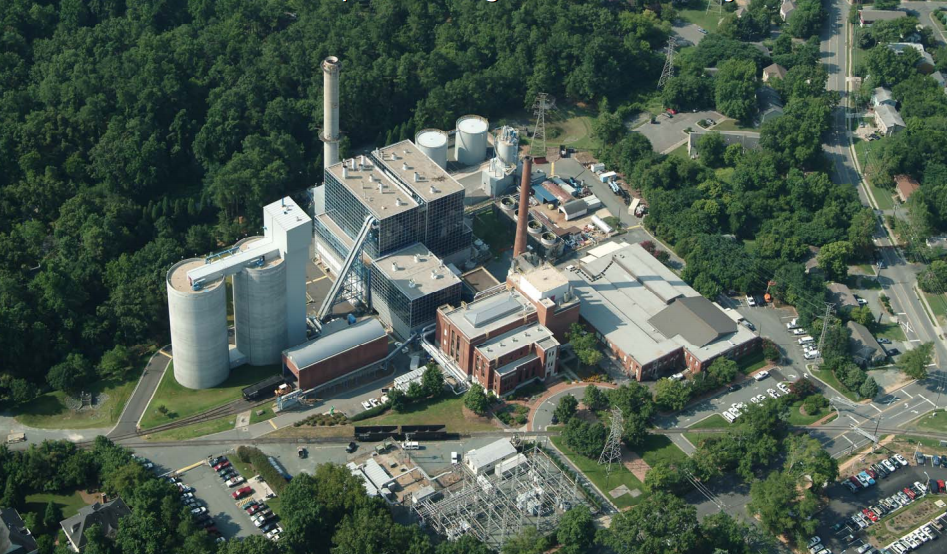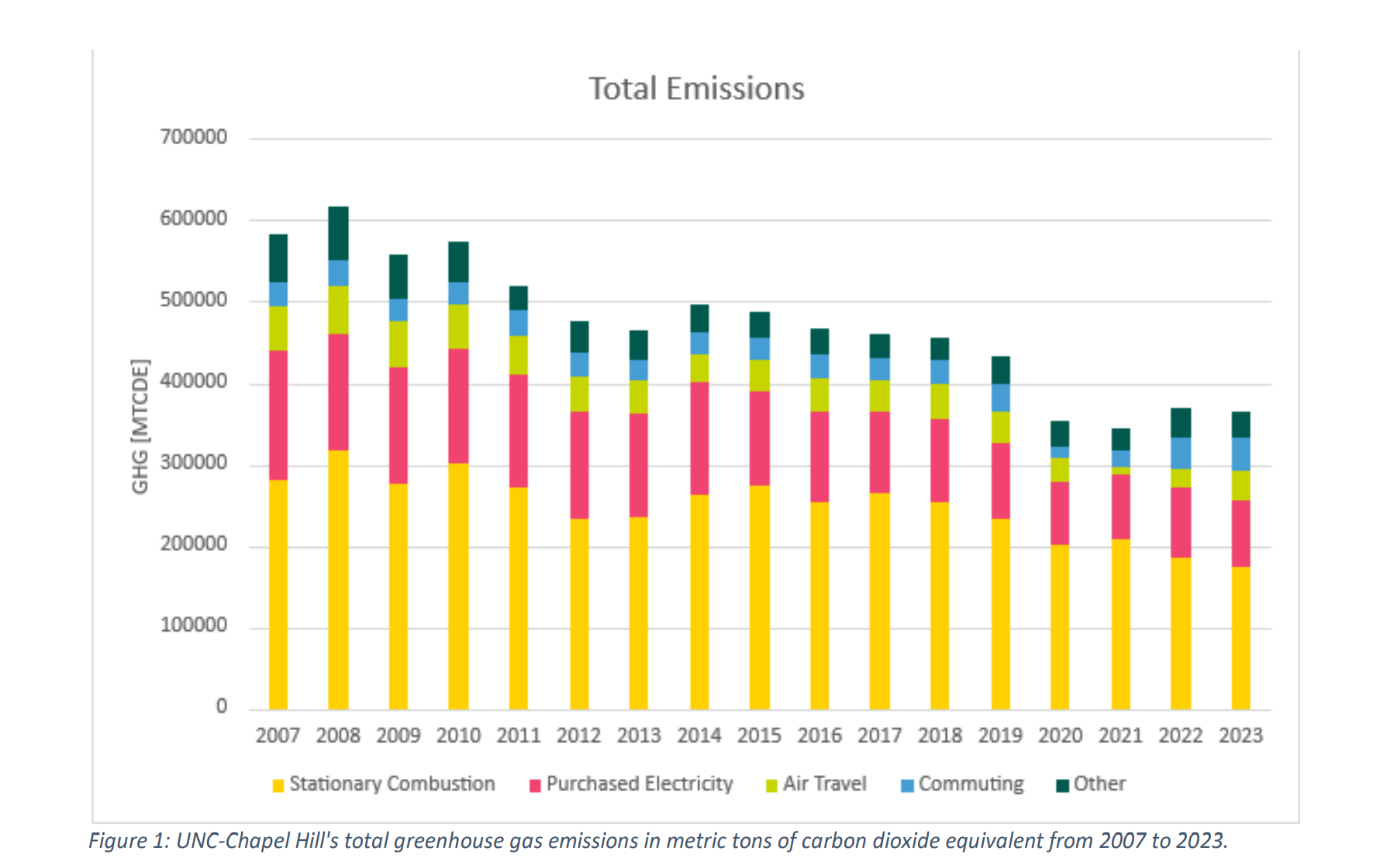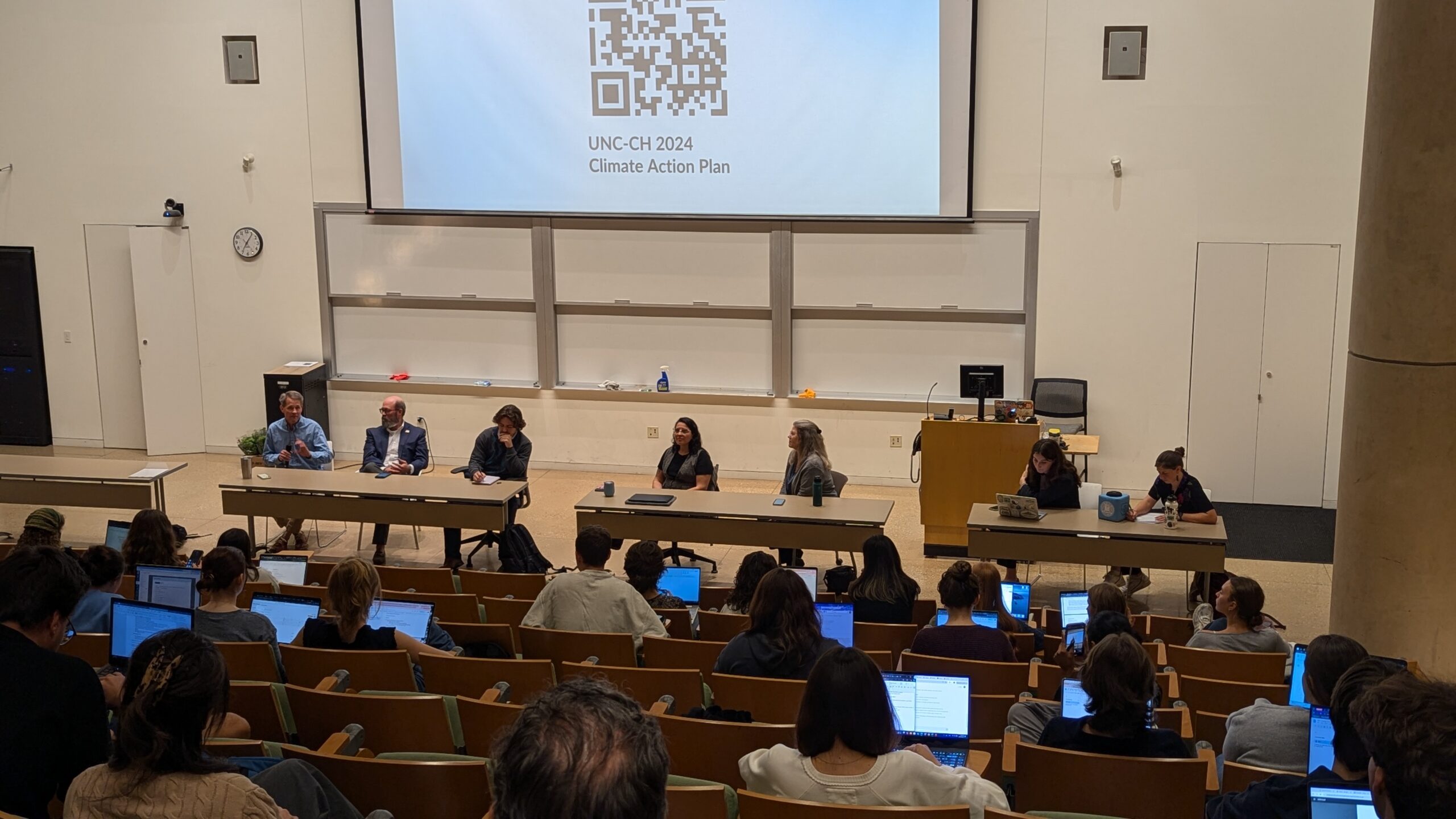For years, the cogeneration plant UNC uses to help power, heat and cool its campus has drawn the ire of campus community members and residents alike. The facility, which is located on West Cameron Avenue, uses coal and natural gas to create steam, and critics have long called for the university to move off of relying on coal because of the carbon dioxide it releases.
During a recent panel updating where UNC stands in those efforts, sustainability officials pointed to improvements in overall and energy-specific emissions rates – but detailed the challenges of moving entirely away from using coal in the short-term.
According to Sustainable Carolina, which oversees UNC’s environmental impact and sustainability efforts, the campus’ overall greenhouse gas emissions output has been trending downward since 2007 – when it began tracking such metrics. The emissions rate is 37% less than 17 years ago, with 25% of that reduction happening since 2019.

An undated aerial photo of UNC’s cogeneration facility on West Cameron Avenue. (Photo via the Carolina Planning Journal/UNC.)

A graph in the 2023 Greenhouse Gas Inventory Report by Sustainable Carolina on its greenhouse gas output, comparing each year from 2007-2023. (Photo via Sustainable Carolina.)
The emissions specifically from the cogeneration plant follow a similar trajectory, which Sustainability Analyst Melanie Elliot contributed to using less coal at the facility.
“Combustion emissions are down 38% from 2007,” she said at the UNC Energy Transition Panel on Oct. 29, “and that’s largely due to the fact our coal consumption is down 67% since 2007. As we’re shifting that fuel mix, our emissions are going to change.”
A major hurdle to eliminating coal entirely, though, is a lack of a solid alternative to use. The plant creates steam to heat and cool buildings, warm up and chill the campus’ water, control humidity and sterilize tools, servicing roughly 40,000 campus users across 200 buildings and the UNC Hospitals campus. Elliot said while the team is continuing to look at alternative fuel mixes, there is no clear and reliable option right now for the university and plant to immediately transition to using.
“Today, we have to have a solid fuel to generate the steam that we need on campus,” she said. “Shutting down cogeneration doesn’t solve anything; it shuts down the university. The only way to be truly carbon-free is to shut everything down… but that’s not really feasible for us, so we have to figure out the best way to maintain operations while reducing emissions.”
It is that reality which partially led Sustainable Carolina to update its climate action plan in 2021 and shift its focus from purely carbon neutrality to net zero greenhouse gas emissions. The latter encompasses all greenhouse gases and allows UNC to focus on cutting back other harmful emissions to reach neutrality – even as the cogeneration plant still creates some carbon dioxide.
The distinction does mean some more hurdles for Carolina, as carbon neutrality often includes buying some form of carbon offset beyond simply reducing emissions. Elliott pointed to Duke Energy, who is a big contributor to UNC’s energy emissions since the university pays for roughly 90% of its electricity from the utility giant (since the West Cameron cogeneration plant operates at an 85/15 spit between creating steam and electricity). Duke Energy is trimming its own emissions – but at a slower rate than UNC, with some of the reduction reflected by purchasing offsets or investing in different clean energy facilities. Similarly, the university is constrained by funding limits and whether sustainability is a priority for shifting regimes – both in South Building and in the General Assembly.

From left to right: Mike Piehler, Brian Litchfield, Max Nelson, Melanie Elliot, and Cindy Shea participate in the 2024 UNC Energy Transition Panel, moderated by Maya Powell and Margot Francini of the UNC Student Government Climate Crisis Committee.
Mike Piehler, the director of Sustainable Carolina and UNC’s Chief Sustainability Officer, oversaw the climate action plan’s 2021 updates after stepping into the role four years ago. While his goal of reaching carbon neutrality by 2040 is aggressive, he points to using technologies and options not available in 2009 when the initial plan was made. Piehler also said the focus on emissions is leading his team to think creatively about different ways to trim those outputs – like examining alternative ways for mid-distance staff travel in the U.S. or promoting mass transit options to get people to campus.
“The climate action plan does a great job defining our emissions [and] setting our goals,” he said, “but also is a great way to look for targeted efforts [for us] to deal with emissions before we have to offset them.”
During the panel, Piehler acknowledged that past university leaders made pledges to move off coal – referencing former Chancellor Holden Thorp’s administration’s promise to no longer use coal by 2020. He said instead of a sweeping deadline for the cogeneration plan or other efforts, Sustainable Carolina will keep a regularly updated webpage to go alongside its climate action plan’s goals and projects.
“We don’t have a coal timeline because we’ve done that before and, in my estimation, if you don’t have certainty about a timeline it doesn’t make sense to give one,” Piehler said. “Rather than give you a timeline, we’ll tell you every year how much progress has been made. We’ve made more progress in the last four or five years than the decade and more prior.
“Should we still be burning coal? Absolutely not,” the chief sustainability officer concluded. “Are we very serious about trying to move on from coal? Absolutely, and demonstrably so.”
Chapelboro.com does not charge subscription fees, and you can directly support our efforts in local journalism here. Want more of what you see on Chapelboro? Let us bring free local news and community information to you by signing up for our newsletter.

